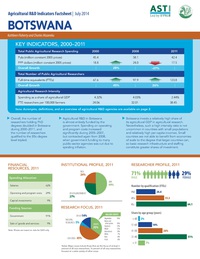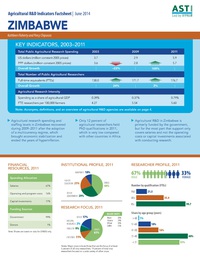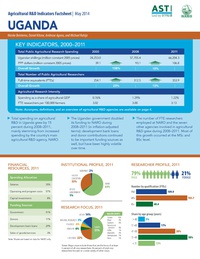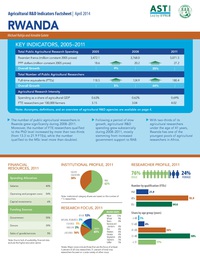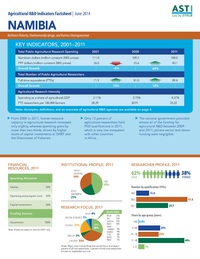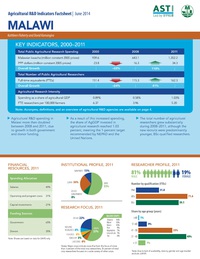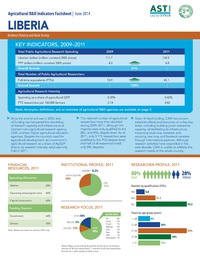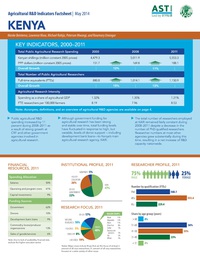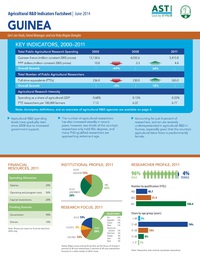Authors:
Kathleen Flaherty and Charles Mazereku
Year:
2014
Publisher
International Food Policy Research Institute and Department of Agricultural Research.
Back to:
Overall, the number of researchers holding PhD degrees doubled in Botswana during 2000–2011, and the number of researchers qualified to the BSc-degree level tripled.
Agricultural R&D in Botswana is almost entirely funded by the government. Spending on operating and program costs increased significantly during 2005–2007, but contracted again from 2008, when government funding to many public-sector agencies was cut due to spiraling inflation.
République centrafricaine : ASTI–ICRA Fiche d’information 2014
Une flambée des investissements dans la R&D agricole pendant la période 2009–2011 succéda à une décennie marquée par une suspension prolongée de l’aide au développement. Dès la fin de 2012, un retour à l’instabilité politique entraîna une nouvelle chute des niveaux de financement.
La part des dépenses de R&D agricole dans le PIB agricole (0,16% en 2011) de la RCA figure parmi les plus faibles de l’Afrique.
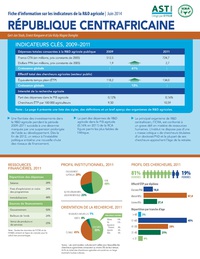
Authors:
Kathleen Flaherty and Percy Chipunza
Year:
2014
Publisher
International Food Policy Research Institute
Back to:
Agricultural research spending and staffing levels in Zimbabwe recovered during 2009–2011 after the adoption of a multicurrency regime, which brought economic stabilization and ended the years of hyperinflation.
Only 12 percent of agricultural researchers held PhD qualifications in 2011, which is very low compared with other countries in Africa.
Agricultural R&D in Zimbabwe is primarily funded by the government, but for the most part that support only covers salaries and not the operating costs or capital investments associated with conducting research.
Authors:
Nienke Beintema, Daniel Kitone, Ambrose Agona, and Michael Rahija
Year:
2014
Publisher
Back to:
Total spending on agricultural R&D in Uganda grew by 15 percent during 2008–2011, mainly stemming from increased spending by the country’s main agricultural R&D agency, NARO.
The Ugandan government doubled its funding to NARO during 2008–2011 (in inflation-adjusted terms); development bank loans and donor contributions continued to be important funding sources as well, but have been highly volatile over time.
Authors:
Michael Rahija and Aimable Gatete
Year:
2014
Publisher
International Food Policy Research Institute and Rwanda Agriculture Board
Back to:
The number of public agricultural researchers in Rwanda grew significantly during 2008–2011. Moreover, the number of FTE researchers qualified to the PhD level increased by more than two-thirds (from 13.3 to 21.9 FTEs), while the number qualified to the MSc level more than doubled.
Following a period of slow growth, agricultural R&D spending grew substantially during 2008–2011, mostly stemming from increased government support to RAB.
Authors:
Kathleen Flaherty, Sheehamandje Ipinge, and Katrina Shiningavamwe
Year:
2014
Publisher
International Food Policy Research Institute
Back to:
From 2008 to 2011, human resource capacity in agricultural research increased only slightly, whereas spending grew by more than two-thirds, driven by higher levels of capital investments at DART and the Directorate of Fisheries.
Only 13 percent of agricultural researchers held PhD qualifications in 2011, which is very low compared with other countries in Africa.
The national government provided almost all of the funding for agricultural R&D between 2009 and 2011; private sector and donor funding were negligible.
Authors:
Kathleen Flaherty and David Kamangira
Year:
2014
Publisher
International Food Policy Research Institute and Department of Agricultural Research Services.
Back to:
Agricultural R&D spending in Malawi more than doubled between 2008 and 2011, due to growth in both government and donor funding.
As a result of this increased spending, the share of AgGDP invested in agricultural research reached 1.03 percent, meeting the 1-percent target recommended by NEPAD and the United Nations.
The total number of agricultural researchers grew substantially during 2008–2011, although the new recruits were predominantly younger, BSc-qualified researchers.
Authors:
Kathleen Flaherty and Mark Yarnlay
Year:
2014
Publisher
International Food Policy Research Institute and Central Agricultural Research Institute
Back to:
Since the end of civil war in 2003, lack of funding has hampered the rebuilding of research capacity and infrastructure at Liberia’s main agricultural research agency, CARI, and two higher agricultural education agencies. Despite the country’s need for agricultural development, its investment in agricultural research as a share of AgGDP (that is, its research intensity ratio) was only 0.42 in 2011.
Authors:
Nienke Beintema, Lawrence Mose, Michael Rahija, Peterson Mwangi, and Rosemary Emongor
Year:
2014
Publisher
International Food Policy Research Institute and Kenya Agricultural Research Institute
Back to:
Public agricultural R&D spending increased by 11 percent during 2008–2011 as a result of strong growth at CRF and other government agencies involved in agricultural research.
Although government funding for agricultural research has been strong and stable over time, total funding levels have fluctuated in response to high, but variable, levels of donor support—including development bank loans—to Kenya’s main agricultural research agency, KARI.
Authors:
Gert-Jan Stads, Famoï Béavogui, and Léa Vicky Magne Domgho
Year:
2014
Publisher
International Food Policy Research Institute and Guinean Agricultural Research Institute
Back to:
Agricultural R&D spending levels have gradually risen since 2008 due to increased government support.
The number of agricultural researchers has also increased steadily in recent years; however, two-thirds of the country’s researchers only hold BSc degrees, and many PhD-qualified researchers are approaching retirement age.
Accounting for just 4 percent of researchers, women are severely underrepresented in agricultural R&D in Guinea, especially given that the country’s agricultural labor force is predominantly female.

